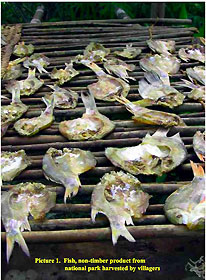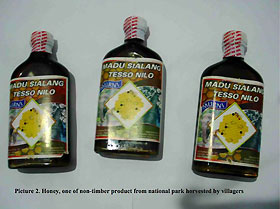(2) (3)
The fieldwork was conducted within 2 months (August-September 2004) in Tesso Nilo, Riau Province, Sumatra, Indonesia. The research site is based in villages surrounding the newly declared Tesso Nilo National Park (declared in 2004). Activities identified in the adjacent areas are logging, timber plantations, oil palm plantations, and settlements. The focus of the study site is Lubuk Kembang Bunga and Air Hitam Villages. Lubuk Kembang Bunga Village, with 521 households, is on the north-east border of Tesso Nilo National Park. The main occupation is logging (316 households/60.7%); the rest practice trading and agriculture, and provide labor for timber plantations. Air Hitam Village, with 286 households, is located on the eastern border of Tesso Nilo National Park. Characteristic occupations in the second village are relatively similar to those of Lubuk Kembang Bunga Village. However, the second village is more ethnically diverse. The majority in the first village consists of the indigenous people of Petalangan while in the second village there are many migrants from Java and West Sumatra. Population pressures on the national park that were identified in the research site are mostly related to illegal logging, poaching and the expansion of agriculture. Except for oil palm plantations, agriculture in the research site currently contributes only a small amount to local people’s livelihoods. Most of the villages are heavily dependent on logging. Forest conversion activities are practiced mainly to establish oil palm plantations. Some other promising sources of income were observed in the research site, such as the collection and crafting of rattan, natural honey production and fishing. The collection of rattan and the making of rattan mats can generate an average income of US$125 monthly. Natural honey harvesting can be conducted 2-3 times in a year, but, at present, honey production fluctuates according to the season. Nevertheless, these activities do provide more opportunities for an integrated approach to the management of the national park. |



 21st Century COE Program
-Aiming for COE of Integrated Area Studies-
21st Century COE Program
-Aiming for COE of Integrated Area Studies-